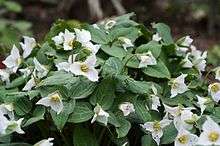Pseudotrillium
Pseudotrillium is a monotypic genus of flowering plants in the family Melanthiaceae containing the single species Pseudotrillium rivale. The genus was proposed in 2002 on the basis of morphology and molecular evidence that suggest the plant should no longer be included in genus Trillium.[2]
| Brook wakerobin | |
|---|---|
 | |
| Scientific classification | |
| Kingdom: | Plantae |
| Clade: | Tracheophytes |
| Clade: | Angiosperms |
| Clade: | Monocots |
| Order: | Liliales |
| Family: | Melanthiaceae |
| Tribe: | Parideae |
| Genus: | Pseudotrillium S.B.Farmer |
| Species: | P. rivale |
| Binomial name | |
| Pseudotrillium rivale (S.Watson) S. B. Farmer, 2002 | |
| Synonyms[1] | |
|
Trillium rivale S.Watson | |
Pseudotrillium rivale, known by the common name brook wakerobin,[3] is endemic to the Siskiyou Mountains of southern Oregon (Josephine, Coos, Douglas, + Curry counties) and northern California (Siskiyou + Del Norte counties), usually on soils of ultramafic origin, such as serpentine.[1][4][5] The Latin specific epithet rivale means “growing by streams”, with reference to a preferred habitat.[6]
Pseudotrillium rivale is a rhizomatous herbaceous perennial growing up to 20 cm (7.9 in) in height. The three bracts have generally lance-shaped blades up to 11 cm (4.3 in) long borne on petioles 1 to 3 cm (0.4 to 1.2 in) in length. The blades are glossy blue-green with silvery venations. Atop the whorl of bracts, on a pedicel 2.5 to 11 cm (1.0 to 4.3 in) high, is a single nodding non-fragrant flower with green sepals and pink-blushed white petals up to 3 cm (1.2 in) long by 2 cm (0.8 in) wide.[7][8]
The plant flowers April to June (late March to early May at the higher elevations). After flowering, the entire plant may enlarge and become more robust and turgid with very glossy leaves. By mid-July, the entire plant withers and goes dormant.[7][8]
Under its former name, Trillium rivale, this plant has gained the Royal Horticultural Society's Award of Garden Merit.[9][10] Hardy down to −10 °C (14 °F), it requires a sheltered position in partial or full shade.[9]
References
- "Pseudotrillium rivale". World Checklist of Selected Plant Families (WCSP). Royal Botanic Gardens, Kew. Retrieved 4 September 2019.
- Farmer, Susan B.; Schilling, Edward E. (October 2002). "Phylogenetic Analyses of Trilliaceae based on Morphological and Molecular Data" (PDF). Systematic Botany. 27 (4): 674–692.
- "Trillium rivale". Natural Resources Conservation Service PLANTS Database. USDA. Retrieved 15 December 2015.
- "Pseudotrillium rivale". County-level distribution map from the North American Plant Atlas (NAPA). Biota of North America Program (BONAP). 2014.
- "Pseudotrillium rivale". Calflora: Information on California plants for education, research and conservation, with data contributed by public and private institutions and individuals, including the Consortium of California Herbaria. Berkeley, California: The Calflora Database – via www.calflora.org.
- Harrison, Lorraine (2012). RHS Latin for Gardeners. United Kingdom: Mitchell Beazley. ISBN 184533731X.
- Jepson Flora Project (ed.). "Pseudotrillium rivale". Jepson eFlora. The Jepson Herbarium, University of California, Berkeley.
- Case Jr., Frederick W. (2002). "Trillium rivale". In Flora of North America Editorial Committee (ed.). Flora of North America North of Mexico (FNA). 26. New York and Oxford. Retrieved July 16, 2019 – via eFloras.org, Missouri Botanical Garden, St. Louis, MO & Harvard University Herbaria, Cambridge, MA.
- "Trillium rivale". www.rhs.org. Royal Horticultural Society. Retrieved 27 February 2020.
- "AGM Plants - Ornamental" (PDF). Royal Horticultural Society. November 2018. Retrieved 17 August 2019.
External links
- Citizen science observations for Pseudotrillium at iNaturalist
- Calphotos Photo gallery, University of California: Trillium rivale